
The biggest driver of high cotton prices today is the low U.S. stocks-to-use ratio, which is expected to remain low this year and continue to be supportive of high prices.
That’s the message Hank Reichle, president and CEO of Staplcotn, drove home in his cotton outlook address to the Southern Cotton Growers/Southeastern Cotton Ginners Association annual convention Jan. 14.
Reichle pointed out that the current U.S. stocks to use ratio is 18.8%. He said any time the stocks- to -use ratio falls below 20%, prices tend to be high.
Reichle emphasized that the stocks-to-use ratio is one of the greatest fundamental determinants of price. He shared USDA data showing a 17.6 million bale U.S. cotton crop in 2021 with domestic consumption pegged at 2.5 million bales and exports earmarked at 15 million bales. He said the market needs to figure out if the stocks to use ratio will remain low.
“Consumption is going up, stocks are going down. This is a very important trend for the market in terms of price,” Reichle said.
Global consumption remains greater than global production which is lowering stocks and driving up prices. In essence, Reichle said the world needs a 124.2 million bale cotton crop this year to meet demand, which would be a record for the world.
“The last time we were around 124 million bales was around 2005 and 2006. There are 1.3 billion more people on earth today than there was in 2005 — 1.3 million bodies that need to eat, need to be clothed, and it’s about time that we set a record.
“Cotton consumption has been struggling a good bit in the last decade. We’ve had plenty of problems thrown at us. The Great Recession hit everyone. After that we had a big-time price recovery that fostered a big transition out of cotton to other fibers and lighter weight products,” Reichle explained.
Since then, the cotton market did grow, but it was hammered by COVID-19 in 2020 when textile mills and clothing stores around the world were shut down for months. Reichle noted that the market did recover from the pandemic, bringing a true V shaped recovery and turning it into a check mark recovery.
“What that means is we snapped back very quickly, and we are growing to consumption levels that are actually greater than they were in the few years leading up to the pandemic. Consumption is very, very positive for the market,” Reichle said.
Reihcle said the 124 million bales of consumption figure is very important. He said the world needs to produce more cotton to meet that 124 million bale mark.
“There was only one time in history where we have been able to grow 124 million bales. The one time we did it was in 2011. There were really, really high prices before then, and people put a lot of money in their crops. Outside of that, we don’t normally grow 124 million bales,” Reichle said.
Reichle said the last time the world produced 124 million bales of cotton, China had the capacity to grow six to seven million more bales than it does today. “They’ve taken that capacity out; it’s not coming back. China had a big decrease in their acreage; it continues to erode just a little bit. I don’t think a lot of that can come back into production.”
He emphasized the market needs to find the acres of cotton production to fulfill that 124 million bales of consumption. “I think that’s very positive if you are a cotton producer.”
About the Author(s)
You May Also Like






